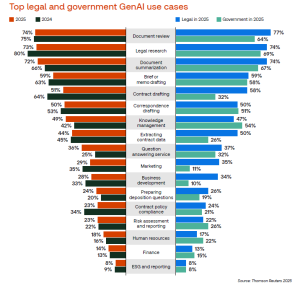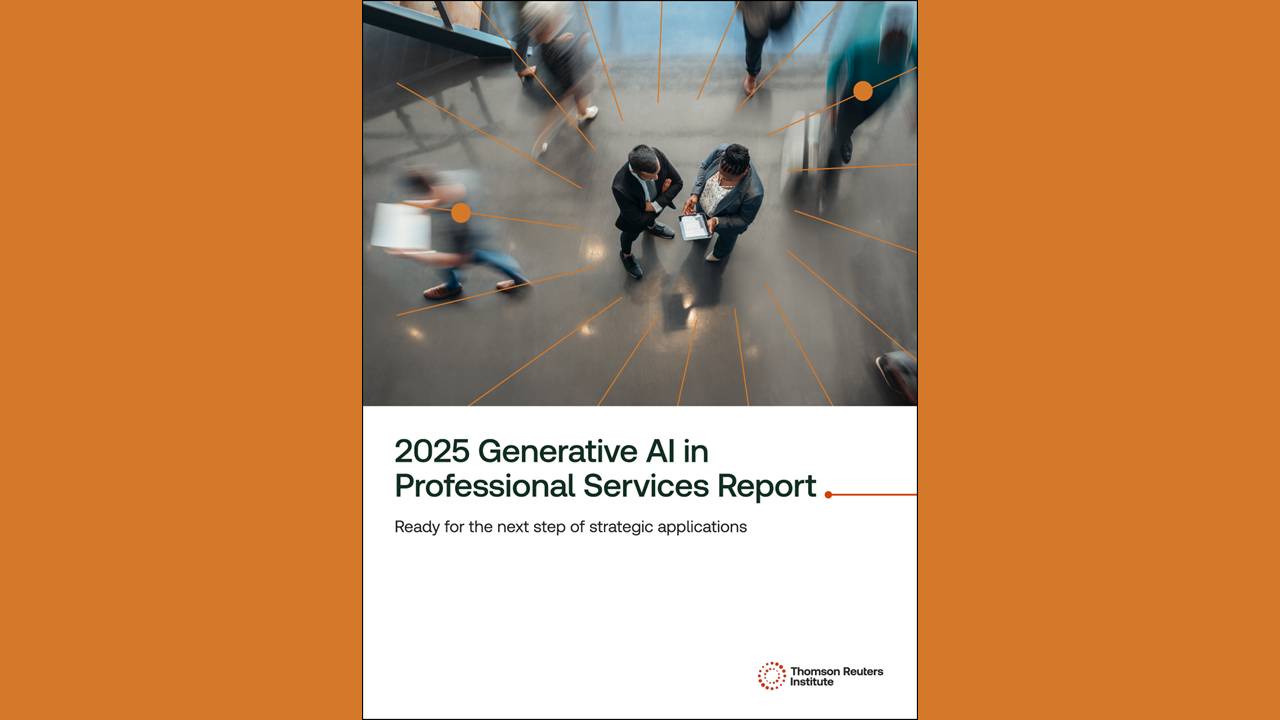Thomson Reuters today released its 2025 Generative AI in Professional Services Report, and it reveals that legal professionals have become increasingly optimistic about generative AI, with adoption rates nearly doubling over the past year and a growing belief that the technology should be incorporated into legal work.
According to the report, 26% of legal organizations are now actively using gen AI, up from 14% in 2024. While only 15% of law firm respondents say gen AI is currently central to their workflow, a striking 78% believe it will become central within the next five years.
Compare those numbers to other surveys I recently reported on here:
- The American Bar Association’s Legal Technology Survey Report, which found that about 21% of law firms were using legal-specific gen AI tools.
- The 2025 Legal Industry Report published by AffiniPay, which found that individual use of gen AI at law firms was at 31%, though organizational adoption was lower at 21%.
- The 2025 State of Law Report from law practice management company Smokeball, which found that AI adoption among small and solo firms had risen from 27% in 2023 to 53% in 2024.
“The GenAI revolution was never really a revolution,” this new Thomson Reuters report states. “GenAI has not broken the ways professionals work or significantly disrupted the interactions between firms and their clients. Instead, for professional services, it has been more of an evolution.”
The survey found that law firm sentiment toward gen AI has shifted markedly over the past year. In 2024, hesitancy was the predominant reaction (35%), but in 2025, excitement (27%) and hopefulness (28%) have taken the lead, while hesitancy has dropped to 24%.
 Document review (77%), legal research (74%), and document summarization (74%) remain the top use cases for legal professionals. Nearly 70% of law firm respondents who use gen AI report doing so at least weekly.
Document review (77%), legal research (74%), and document summarization (74%) remain the top use cases for legal professionals. Nearly 70% of law firm respondents who use gen AI report doing so at least weekly.
“It is incredible how quickly legal professionals have moved from skepticism to strategic adoption of gen AI, and we are seeing it firsthand through use of our AI solutions,” Raghu Ramanathan, president of legal professionals at Thomson Reuters, said in a statement commenting on the report. “The legal sector is embracing gen AI not as a threat but as an ally, and this isn’t about replacing legal expertise—it’s about enhancing it.”
Despite this growing adoption, the report identified several gaps in implementation strategies:
- Only 41% of law firms have established policies governing gen AI use (either specifically or subsumed within a broader tech policy).
- Just 40% provide any form of gen AI training to staff.
- Merely 20% of organizations are measuring return on investment for gen AI tools.
- 71% of corporate legal clients don’t know whether their outside law firms are using gen AI.
“If 95% of professionals believe GenAI will be central to their organizations’ workflow within the next five years, presumably, new hires today should be present and engaged when GenAI comes to the fore,” the report notes. “However, even setting aside respondents who don’t know their organization’s hiring plans, a large proportion say their organizations are not targeting applicants with those skills.”
The report concludes that for legal organizations to fully capitalize on gen AI’s potential, they must move beyond initial adoption to strategic implementation, including measuring outcomes, establishing governance frameworks, and having explicit conversations with clients about how and when gen AI is being used.
The Thomson Reuters Institute survey included 1,702 respondents across legal, tax, accounting, audit, corporate risk, fraud, and government sectors. The data was collected in January and February 2025, with legal professionals making up 41% of respondents.
 Robert Ambrogi Blog
Robert Ambrogi Blog